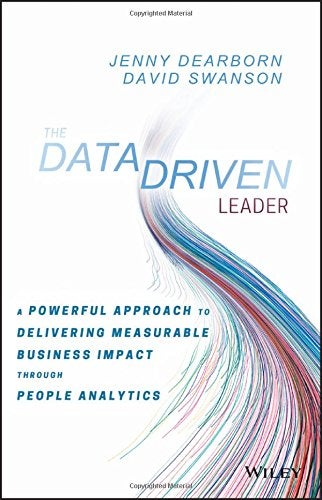 Big data has become a necessity for many businesses, but some human resources managers don’t rely on it because they see their role as something different: connecting to the employees and the company. In their book, The Data Driven Leader: A Powerful Approach to Delivering Measurable Business Impact Through People Analytics, Jenny Dearborn and David Swanson say failure to incorporate data into the HR function can be costly to managers and the company. Dearborn, chief learning officer and senior vice president at SAP, discussed the book on the Knowledge at Wharton show, which airs on SiriusXM channel 111. (Listen to the full podcast using the player at the top of this page.)
Big data has become a necessity for many businesses, but some human resources managers don’t rely on it because they see their role as something different: connecting to the employees and the company. In their book, The Data Driven Leader: A Powerful Approach to Delivering Measurable Business Impact Through People Analytics, Jenny Dearborn and David Swanson say failure to incorporate data into the HR function can be costly to managers and the company. Dearborn, chief learning officer and senior vice president at SAP, discussed the book on the Knowledge at Wharton show, which airs on SiriusXM channel 111. (Listen to the full podcast using the player at the top of this page.)
An edited transcript of the conversation follows.
Knowledge at Wharton: Do you see this book as a teaching tool for companies and their human resources department?
Jenny Dearborn: Yes. It really is designed for executives across all the different functional areas, but especially for HR. It’s HR professionals who are supposed to be monitoring and coaching and encouraging the right behavior for leaders across the company.
Knowledge at Wharton: When you think about how leadership and HR work together, what links big data between the two?
Dearborn: Historically, HR departments have been run by wonderful people who are great people-people. They are great at the human interaction. They’re great at being empathetic. They’re wonderful at caring deeply about how people feel, and that’s fantastic. But to be a competitive differentiator moving forward, we need to move beyond that. We need to use all of the tools available in order to be more effective. Every other functional area in a business is using all of these resources, all of the data and insights. HR needs to use that, too, for their primary responsibility, which is to groom the leadership skills across the company.
Knowledge at Wharton: Does this require HR professionals to change their point of view about their roles in the company?
Dearborn: Absolutely. It really is taking HR departments by surprise, which is part of the motivation for writing this book. It’s trying to give my peers the tools they need to keep up and be effective. One of the pieces of research that I cite in the book is that in 2016, for the very first time, more than 50% of the newly appointed chief human resources officers did not come from HR.
“Most companies have all the data that they need, they just don’t know how to use it.”
If you started at the bottom in HR, you’d think, “With time, I’m going to get to that top job.” Now, more than 50% of the time, that’s not going to be somebody who has started at the bottom. It’s going to be somebody who came laterally from the head of marketing or operations or sales or finance or pretty much anywhere else. The No. 1 reason why is the lack of expertise in data and analytics.
Knowledge at Wharton: Do you expect to see HR departments bringing data scientists into their operations?
Dearborn: That is the No. 1 requested new job that all HR departments around the world are looking for. At the top of their list is somebody who can drive the data and analytics for their department, so every HR department is looking for data scientists. It’s unusual to go to a university recruiting event, go to the data science or statistics department and say, “Hi, I’m in HR. Do you want to come to HR?” The undergraduates are scratching their heads, but it really is the trend.
Knowledge at Wharton: What are the roadblocks for HR in terms of getting access to data?
Dearborn: Oftentimes, the internal data in an organization is kept in lots of different places, so it is not consolidated neatly. I’ve never known of any company where all the data is consolidated neatly. You have sales data in the sales department. You’ve got customer interaction data in customer service. You’ve got productivity numbers all over the place. The coming together of all of this information is where the power is.
Each of these groups is going to hold on to the data they have because it’s a sense of power for them. They’re concerned with: “If I give you this information, how are you going to use it to potentially make me look bad, make me look like I missed a trend or that I wasn’t doing my job as well as I could have?” There’s a lot of searing skepticism about giving over raw data to a central group and saying, “Triangulate this. Put some algorithms on top. See what you come up with.” People are quite reluctant to share.
Knowledge at Wharton: You point out that executives don’t always make decisions based on the data points that are provided to them. Why not?
“There is a very narrow group of people who are making really powerful decisions using data.”
Dearborn: My hypothesis is that most companies have all the data that they need, they just don’t know how to use it. They don’t know how to put it together or what questions to ask. They don’t really know what they’re looking for.
Most companies have tons of information about their customers, about which accounts are more productive, which accounts are high margin, and which accounts are a complete waste of time because the return isn’t there. Companies know this. But they don’t have the time or the discipline to take a step back and ask themselves tough questions like: What are we doing here? What is our purpose? What are our goals? What are we trying to achieve? What is the best way to get there?
Knowledge at Wharton: Companies have all of this data at their fingertips and don’t really know what to do with it, which is a big problem. It’s also a little scary, considering the concerns about the use and protection of data.
Dearborn: There are significant concerns around data privacy. What are you going to do with this information? What is it going to say about me, about my behavior, about my buying patterns, about who I am? How is this information going to reveal something that maybe I don’t want to have revealed to my customers, to my employer? There are also a lot of concerns about employer’s rights in all of this. Some countries have very strong rules and regulations around data privacy, and other countries are less restrictive. It really is kind of a wild west right now.
Another strong theme in the book, and in a lot of the speaking that I do, is around the importance of diversity in the data scientists so that we can make sure the questions being asked of the data — and the decision-makers of how artificial intelligence and machine learning are being used — are really representative of a diverse perspective across society.
There is a very narrow group of people who are making really powerful decisions using data. It would be better for all of us, in corporations and society, if it was more open and more transparent around how the data is being used, what decisions are being made and if a diverse group of people was engaged in that decision-making.
Knowledge at Wharton: How has your understanding changed you as an executive at SAP?
Dearborn: It has made me significantly more empathetic to the rights of everyday employees and everyday people.
I started this journey wanting to get more information so that I could prove the value of the work that I was doing. I was in charge of a huge department. We had a significant charter to go roll out learning and development in a corporation. Someone said, “How do you know what you’re doing is actually making a difference?” I decided to dig into data and information to get facts to support that what I’m doing is actually making a difference and making a positive contribution to my corporation.
That was the start of my journey. The more I got into it, the more I said, “Wow, this is really powerful.” I now have insights into people’s behavior, people’s choices.
The more sophisticated your analyses are, the more you can start to predict the future. You can say, “I believe this employee will be successful in the future. There is a 90% confidence rate that this particular employee will make quota at the end of the year. I believe this other leader will likely fail, unless there is some sort of intervention.”
You extrapolate that out, and you can start to predict behavior. That’s really powerful. It’s a wonderful tool for a corporation to make sure that they meet their revenue targets. But there are bigger implications for us as a society. I’d love for us, as humans, to be having this conversation about the power of this. How can we use this for good? How can we use this to make the world a better place and improve people’s lives?


